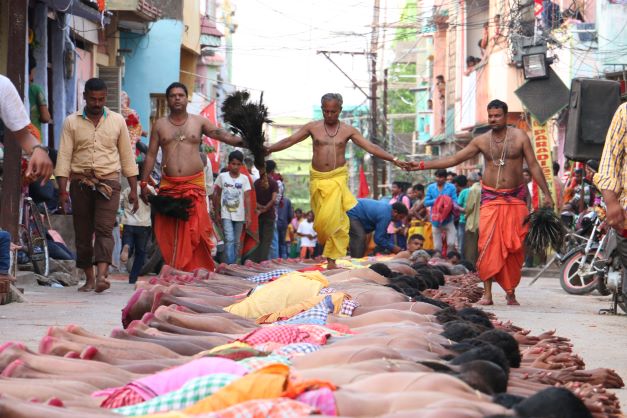‘Danda Nacha’ Fervour Grips Ganjam District Of Odisha

Berhampur: Come spring and Ganjam comes alive with ‘Danda Nacha’ for 3 weeks. The sound of drums, cymbals and conch shells reverberated the air as the festival started with a religious fervour from ‘Chaitra Sukla Chaturthy’ on March 25.
During the festival, the participants of Danda, called Danduas (also Bhoktas), pray to Goddess Kali and Lord Shiva for 13, 18 or 21 days of penance. It culminates on Bishuba Sankranti which is called Meru Sankranti on April 14.
‘Danda’ as the name implies, is self-inflicted punishment, which the ‘Danduas’ undergo to pay their obeisance to Maa Kali. It is also a form of worshipping Lord Shiva and his consort Parvati. The ‘Danduas’ undergo a lot of pain and hardship to appease the Goddess. Only male persons take part in this festival.
Danda Nacha is the amalgamation of 16 traditional folk dance format and is the only such dance form in the whole world, said Hrushikesh Panigrahi, the renowned researcher who is instrumental in the revival of cultural renaissance in Ganjam.
It starts with the Binakar during the wee hours and ends on the wee hours of the next day. The dance is performed in three phases including ‘Dhuli Danda’, ‘Pani Danda’ and ‘Agni Danda’. ‘Dhuli Danda’ takes place in the afternoon when the ‘Danduas’ roll bare bodied on the hot soil under the scorching sun. During sunset, they assemble at a nearby pond to perform rituals of ‘Pani Danda’. With the arrival of night ‘Agni Danda’ comes with its marvelously awe-inspiring rituals, which enthralls the onlookers.
The Danduas generally stay near a temple or some sacred place and stay away from their near and dear ones to concentrate on worshiping. They move out from their stay in the morning amidst beating of drums and blowing of conch and trumpet. When they move in rows with red and yellow flags, the locals seek their blessings.
‘Danduas’ perform on the streets and in front of one house each day when they are asked to do so by a particular house owner. The dance takes place in groups consisting of 40 to 100 ‘Danduas’ and the expenses amounting to thousands of rupees. The head of the group is called ‘Bada Patta Dandua’ or ‘Bada Patta Bhukta’.
The dance group is very carefully selected. There is a strict dress code with only white, yellow or saffron cloth being used. The ‘Danduas’ eat only once in a day and they do not even take water till ‘Pani Danda’ in the evening. Though the dance is very ritualistic, there is no caste bar for participants.
According to mythology, 13 sons of the great saint Tarani in ‘Tretaya Yug’ practised self-inflicted ‘punishment’ to appease Lord Brahma who cursed them for their misdeed. Another legend says 13 sons of Indra and Kubera criticised the great saint ‘Astabakra’ who cursed them to be born in ‘Martya’ and suffer a lot.
Walking bare-footed, the Danduas perform their rituals on the roads during the day. At the very spot makeshift stages are erected for theatre shows during night. Households and bazaar committees invite these troupes to perform Danda Nacha in their area as a worship to the Goddess.
A host of other dances are performed during late night. The Fakir and Fakirani, a group dance, is performed first. Then the Savara and Savaruni are performed with the Chadeya and Chadeyani dances. Then everyone gets involved in the festivities by performing a leela through songs and dances, which is based on a story from various Puranas. After the leela, the Patarasaura and Patarasaurani perform their traditional dance. Lastly, the Binakar ends the events through dances and songs.
The music is different for different dances and songs are of different tunes for different characters. The songs are mainly devotional and mostly based on stories from the epics.

Comments are closed.